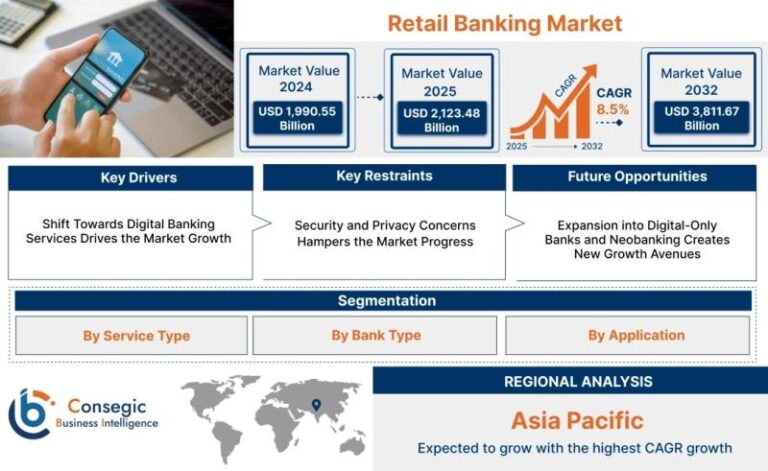“
The Retail Banking Market is undergoing a dynamic transformation, fueled by technological innovation, evolving consumer expectations, and a growing emphasis on financial inclusion. This market encompasses a broad range of financial services catering to individual consumers, from basic savings and checking accounts to complex wealth management solutions. Key drivers for growth include the proliferation of digital banking platforms, increasing smartphone penetration, and the rising demand for personalized financial services. Technological advancements such as artificial intelligence (AI), blockchain, and cloud computing are revolutionizing retail banking operations, enabling enhanced customer experiences, improved risk management, and greater operational efficiency. Furthermore, the retail banking sector plays a crucial role in addressing global challenges such as financial inequality and promoting sustainable development by providing access to financial services for underserved populations and supporting environmentally responsible initiatives. The market is becoming increasingly competitive, with traditional banks facing disruption from fintech companies and non-bank financial institutions that are leveraging technology to offer innovative and customer-centric solutions. As the world becomes more interconnected and consumers become more digitally savvy, the retail banking market is expected to continue its growth trajectory, driven by the need for secure, convenient, and personalized financial services.
Get the full PDF sample copy of the report: (TOC, Tables and figures, and Graphs) https://www.consegicbusinessintelligence.com/request-sample/2258
Market Size:
The Retail Banking Market size is estimated to reach over USD 3,811.67 Billion by 2032 from a value of USD 1,990.55 Billion in 2024 and is projected to grow by USD 2,123.48 Billion in 2025, growing at a CAGR of 8.5% from 2025 to 2032.
Definition of Market:
The Retail Banking Market encompasses financial services offered by banks and other financial institutions directly to individual consumers. It’s a segment of the broader banking industry focused on providing banking products and services to the general public, rather than to corporations or other institutions.
Key components of the Retail Banking Market include:
Savings Accounts: Deposit accounts that allow customers to save money and earn interest.
Loans: Funds borrowed by customers for various purposes, such as personal expenses, education, or home improvement.
Mortgages: Loans specifically for purchasing real estate, secured by the property itself.
Credit Cards: Revolving credit accounts that allow customers to make purchases and pay them back over time.
Wealth Management: Advisory and investment services for high-net-worth individuals, including portfolio management and financial planning.
Key terms related to this market include:
Net Interest Margin (NIM): A measure of a bank’s…
Read More: Retail Banking Market Growth Outlook: Current Scenario, Future




